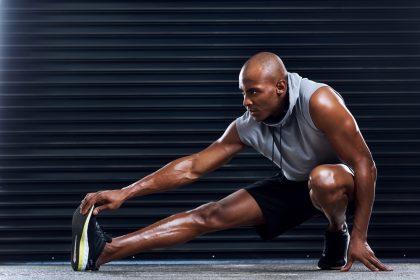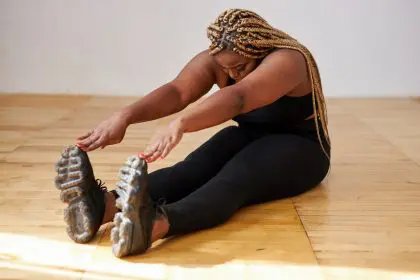You’ve tried everything. The ergonomic chair that cost half your paycheck. The posture apps that buzz angrily when you slouch. The well-meaning but ultimately unhelpful advice to “just sit up straight.” Yet somehow, your shoulders still round forward, your neck still cranes toward your screen, and your back still aches by mid-afternoon.
What if the solution isn’t another gadget or reminder, but a simple stretch so effective it can reset your posture almost instantly? A movement so fundamental to human biomechanics that it counteracts hours of modern life in just seconds?
The forgotten movement your body craves
We’re talking about the thoracic bridge, though you probably know it by another name — the chest opener, the heart opener, or simply “that stretch where you arch over a foam roller.” Whatever you call it, this powerful position targets the exact areas that collapse during our daily forward-focused activities.
What makes this stretch so uniquely effective is how it works with your body’s natural design rather than against it. Your thoracic spine — the middle section of your back connected to your ribcage — is meant to extend and rotate. Yet modern life rarely asks it to do either. Instead, we spend hours hunched forward, training our bodies to adopt this collapsed position as normal.
The thoracic bridge reverses this pattern by creating gentle, supported extension precisely where your body has become restricted. Unlike many posture corrections that feel like punishment, this stretch delivers immediate relief along with its alignment benefits.
The magic happens because this position addresses multiple postural problems simultaneously. It opens the chest muscles that have shortened from constant forward positioning. It mobilizes the thoracic vertebrae that have become locked in flexion. It repositions the shoulder blades that have rotated forward and up. And perhaps most importantly, it retrains your nervous system’s understanding of what “neutral” should feel like.
How your ribcage holds the key to better posture
Most posture advice focuses on the shoulders, telling you to pull them back and down. But this approach misses the underlying issue. Your shoulders are merely responding to what’s happening in your ribcage and spine.
When your ribcage tilts downward in front due to thoracic spine restrictions, your shoulders have no choice but to follow, no matter how much you force them back. It’s like trying to hang a picture frame straight on a tilted wall — the underlying angle makes proper alignment impossible.
The thoracic bridge addresses the root cause by repositioning your ribcage. As your thoracic spine extends, your ribcage naturally lifts, creating the proper foundation for your shoulders to rest in their optimal position. This is why the effects of this stretch feel so different — you’re not fighting your body’s structure, you’re restoring it.
What’s particularly remarkable about this approach is how quickly it works. While most postural interventions take weeks or months to create change, the thoracic bridge can create noticeable improvement in minutes. This immediate feedback makes it easier to understand what proper alignment actually feels like, giving your body a clear template to return to.
The neurological reset that makes it stick
The thoracic bridge does more than just stretch tight muscles — it actually resets your body’s proprioception, your internal sense of where your body parts are in space.
After hours of poor positioning, your nervous system begins to accept the collapsed posture as normal. Your brain essentially redraws the map of what “straight” feels like, which is why simply trying to stand up tall often feels strained and unnatural.
By placing your spine in a gently extended position, the thoracic bridge reactivates the stretch receptors along your back, sending fresh sensory information to your brain. This updated input helps recalibrate your internal posture map, making proper alignment feel natural rather than forced.
This neurological reset explains why people often stand differently immediately after performing this stretch. It’s not just that tight muscles have been loosened — your entire sensory system has received updated information about where your body should be in space.
The effect is similar to restarting a computer that’s running sluggishly. Sometimes the system just needs to clear its cache and reset to function properly again. Your body’s proprioceptive system works the same way, occasionally needing a clear reset to remember its optimal settings.
The desk worker’s salvation
For those who spend hours at computers, the thoracic bridge offers particularly dramatic benefits. The continuous forward position of desk work creates predictable patterns of tightness and weakness that this single stretch directly counteracts.
The pectoral muscles across your chest shorten and thicken from being held in a contracted position. The rhomboids between your shoulder blades become overstretched and inhibited. The small but crucial muscles between your ribs, the intercostals, lose their elasticity. All of these changes lock you into a collapsed posture that feels increasingly “normal” despite being biomechanically harmful.
The thoracic bridge addresses each of these issues simultaneously. As your chest expands, those shortened pectorals finally release. As your shoulder blades draw together, those inhibited rhomboids wake up. As your ribcage expands, those stiffened intercostals regain their proper length and tension.
Many desk workers report that this stretch provides their first experience of truly upright posture in years — not the artificially stiff military stance that most envision as “good posture,” but the effortlessly stacked alignment that humans evolved to maintain.
Perfecting the movement for maximum impact
The basic thoracic bridge is simple but nuanced. To perform it effectively, you need a foam roller or a firmly rolled towel or yoga mat. Place the roller horizontally on the floor and lie back so it sits under your mid-back, roughly at the bra line or where your lower ribs meet your sternum.
Support your head with your hands, keep your feet flat on the floor, and allow your hips to remain grounded. The key is to let gravity gently draw your upper body into extension without forcing the movement. Your ribcage should expand upward as your shoulder blades melt toward the floor.
Breathe deeply into the stretch, feeling your ribcage expand in three dimensions. Many people make the mistake of holding their breath during this position, which prevents the full release of tension patterns. Each exhale is an opportunity to settle deeper into the position, letting go of restrictions that have accumulated over time.
For maximum benefit, slowly roll up and down your thoracic spine, pausing at areas that feel particularly tight. Each segment of your mid-back can become restricted independently, so this exploration helps ensure you’re addressing all potential problem areas.
The beauty of this stretch lies in its adaptability. Those with significant restrictions might only manage a slight extension at first, while more mobile individuals might achieve a deeper backbend. Either way, the movement meets you where you are and provides appropriate stimulus for your current level of mobility.
Beyond the basic bridge
Once you’ve mastered the fundamental thoracic bridge, subtle variations can target specific postural issues.
Extending one arm overhead while maintaining the bridge position adds a rotational component that addresses asymmetrical patterns common in phone users who always hold their device on the same side. The gentle twist helps mobilize individual vertebral segments that may have become locked.
Adding gentle arm movements while maintaining the extended position helps integrate your newly found spinal position with shoulder function. Simply opening and closing your arms while bridged trains your body to maintain proper thoracic position during dynamic movements.
For those who spend hours in forward head posture, adding a gentle chin tuck while in the bridge position helps reset the relationship between your cervical and thoracic spine, addressing the notorious “text neck” pattern that’s becoming increasingly common.
The two-minute posture solution
The most powerful aspect of the thoracic bridge is its efficiency. Even a two-minute session can create noticeable changes in how you carry yourself. This makes it perhaps the highest-return exercise in the postural toolbox.
Try performing this stretch first thing in the morning to set your posture for the day, after long periods of sitting to undo accumulated compression, and before bed to prevent carrying daytime postural stress into your sleep position.
Unlike complicated posture routines that often get abandoned, this single movement is simple enough to become a sustainable habit. It requires minimal space and equipment, can be performed in regular clothing, and delivers immediate feedback that reinforces its value.
Your body already knows how to stand properly. Sometimes it just needs a clear reset to remember. The thoracic bridge provides exactly that — a return to the aligned, extended posture that humans maintained for thousands of years before screens, desks, and smartphones changed how we hold ourselves in the world.

















